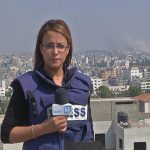By
Maha Elbanna
From Beit Hanoun in the north of Gaza all the way to Rafah in the south, the scene repeats itself. Everywhere you look, all you can see are piles of dusty, colorless and lifeless rubble. Walls, bricks and columns of cement are piled on top of each other as if to hide the life that once was there.
A 72 hour ceasefire that started on Tuesday morning allowed people to take a short break from the continuous fighting. The streets were too crowded and thousands of people got out, some to catch much needed supplies, while others went to check the damage to their homes. And while thousands of people have died during the Israeli assault of just under one month, others, who survived massacres, are ready to tell the stories of those who are gone.
Standing on the rubble of where her house used to be, Amna spoke of her ordeal at the UN-run school in Jabalia which was her shelter for a week. “We left our house and the next day it was bombed. We stayed at the school for seven days and then we were told to leave. We started gathering our things and headed towards the playground waiting for the buses,” she said with her lips trembling, adding “all of a sudden, bombs were falling on us. I lost my son, and got injured in my leg. My other son still has shrapnel wounds in his face, while my granddaughter lost her arm. We lost our kids, homes and money all because of Israel.”
In Beit Hanoun, Abu Khalil’s house was not bombed but it was severely damaged. “My house is sandwiched between two other houses which were hit with F16 missiles. All the rooms in my house were destroyed except for one. Fifteen people are now living in that room. I myself sleep in the balcony.” He said.
And while people are hopeful that the current lull will be extended and that ongoing negotiations in Egypt lead to a long term ceasefire, people know that once peace is restored, what lies ahead is a very difficult stage of rebuilding their homes. along with their lives.
And as we drove south, Khuza’a, east of Khan Younes, once green and abundant with gardens and trees, looked different today. We were shocked to see the scale of destruction in this small town. The entire area had been wiped out. Ashes and burned homes were all that was left. Nothing was saved; no mosques, no homes; no one, the streets hardly recognizable.
“I came to see what happened to my home. There are no homes left in Khuza’a. It’s all been wiped out. Where are we going to go? Where will we live? Even my animals were killed” said Sabha, who came to look for her belongings among the rubble, with eyes full of despair.
And as if answering her own questions, she added: “We will come back and we will rebuild our homes. Once the Israeli aggression is over, I will come back and put a tent on top of the rubble of my house and I will stay here,” she said as she was trying to salvage some kitchen items from under her house’s rubble, albeit in vain.
Loss of lives, coupled with loss of property left people with so much agony to deal with. A young man was holding pictures of his cousins while crying. “My aunt was the only survivor. She sent me to look for her kids’ pictures and belongings. They all used to live here and now they’re all gone,” said the young man, still with tears in his eyes. “She was injured, and when she came out of the hospital, she found out that she lost all three of her boys. She wanted me to come to her house and look for anything that might have their memories,” he added.
The Gaza Strip is one of the most densely populated areas in the world, with more than 5000 people per square kilometer. Right now, close to half a million people are displaced. Many of those will be able to go back to their homes, while others will not have homes to go back to. Those will remain displaced for a long time as it will be difficult to provide them with alternative housing due to the large numbers.
Maha Elbanna is a Palestinian American journalist. She works as a news reporter for the Saudi TV English Channel. Having lived and worked in Gaza Strip for the past nine years, she has reported on three wars, an internal rift and other major events. Maha also works for a health NGO, teaches English language and translates for an online news website.



Thank you for "Stories Under the Rubble," Maha. Please stay safe. I wish an Israeli rescue mission would come in to save some of the innocents. I wish the ancient excuses for hatred would evaporate. I have shared your article on Facebook and with my friends at AFSC.